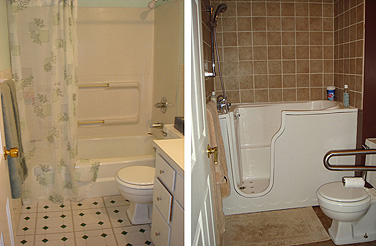News
Home modifications are changing lives

Simple changes like a bathroom modification (right) can have a life-changing impact on persons with disabilities by allowing them to live more easily in their home.
-
 Print
Print -
 Comments
(1)
Comments
(1)
-

“They don’t only love it because they love the aesthetics of it. They love it because it has changed their lives.”
Even the smallest of home renovations can change the life of someone with a disability. Widening a doorway or adding grab bars around a toilet can mean the difference between independence and dependence—between comfort and discomfort in one’s own home.
That knowledge is what has driven architect Danise Levine to design about 475 home modifications over the past 15 years as a member of the Center for Inclusive Design and Environmental Access (IDeA Center) in UB’s School of Architecture and Planning.
“You see people in their homes and they’re restricted by their environment. To try and overcome this, they tend to adapt their behavior to their environment instead of adapting their environment to fit their behavior. It’s very rewarding when you can help change that,” Levine says.
Levine, now the IDeA Center’s assistant director, began working on home modifications in 1996, soon after graduating from UB’s architecture master’s degree program.
She works for small fees and, on occasion, has offered services pro bono. Most of her clients are families whose children have disabilities. But people who have sought her help include individuals who have lost their mobility as the result of an accident, as well as older adults hoping to live comfortably in their homes as they age.
Levine is also a member of an expert team helping the U.S. Army design family housing for wounded veterans through the “Wounded Warrior Home Project.” Two model homes that employ universal design principles are nearing completion at Fort Belvoir, Va.
On average, Levine works on two or three modifications a week, primarily in Western New York. Through her diverse experiences, she has learned to navigate the state system that funds modifications and solidified her understanding of the amount of work contractors can complete with limited money.
On the job, Levine works closely with families to discern their needs.
“Everyone’s situation and needs are different,” she says. “It’s about taking a look at what the person needs today and also anticipating what their needs will be a few years from now.”
Levine’s ability to understand her clients is one reason her modifications are successful, says Carol Kizis. Kizis and her husband, UB faculty member Joseph Gardella, hired Levine in the late 1990s to design renovations and an addition to their home in North Buffalo.
The couple’s daughter, now 20, uses a wheelchair due to cerebral palsy and they wanted to enable her to move about their home independently.
With Levine’s expertise, the family widened doorways, installed an elevator, added accessible bathrooms and created two accessible entries to the home. Some changes, like raising the height of the dishwasher or moving electrical outlets higher on walls to facilitate access, have made the house more comfortable for the entire family.
At the front door, Levine designed a ramp that not only serves a practical purpose, but blends in with the aesthetics of the house. (The ramp is tucked behind short, concrete walls that look like a set of stairs from the street.)
“I loved her,” Kizis says of Levine. “She put up with my questions. She listens to you, but also offers you an honest opinion of how it’s going to be. If she thinks you’re going to make a big mistake, she’ll tell you.”
As a result of the modifications, Kizis says her daughter “can go where she wants to go.”
“That, I think, is the big thing,” Kizis continues. “Often, a person with a disability ends up having a bedroom on the first floor. But our bedrooms are on the second floor and we didn’t want our daughter to be separated from us. Because of the elevator and the modifications we completed, our daughter’s bedroom is also on the second floor. She is an equal.”
For Levine, that’s the greatest reward—the changes she sees in her clients’ daily lives.
“A lot of times, I don’t get the opportunity to go back to see the modifications after they’re done. But when I do, it’s incredible to see it,” she says. “It’s not so much the physical product that I’m awed by. It’s the change in the person’s behavior and the change in what they can do. They don’t only love it because they love the aesthetics of it. They love it because it has changed their lives.”

Reader Comments
nancy haas says:
For many years , before returning to UB , I worked in homecare as an LPN. My patients were severely disabled due to cerebal palsy , cervical injuries , ms and md,,,,,,,, those families were challenged in so many ways , just to provide basic care. It is wonderful to hear that a proffesional such as Danise is so commited to using her skills to help those patients and families.
Posted by nancy haas, amazing !, 10/12/11